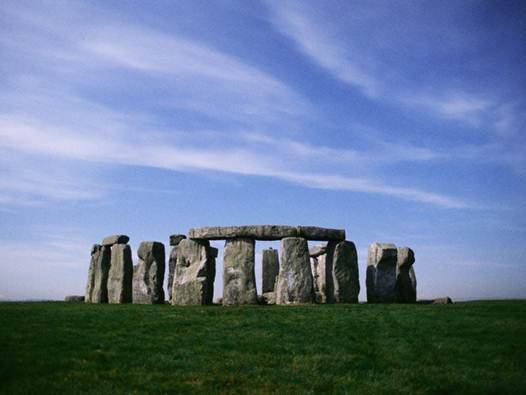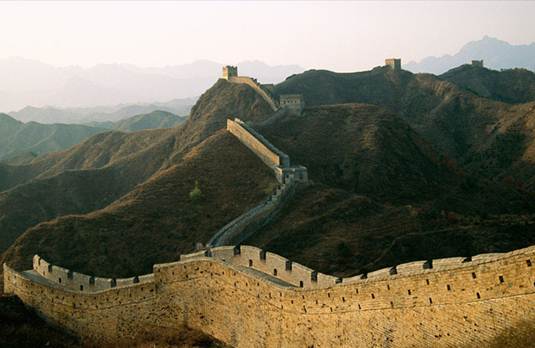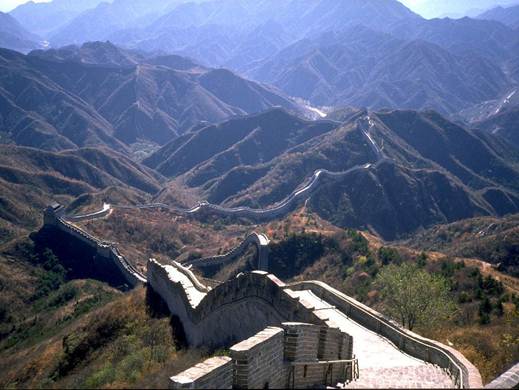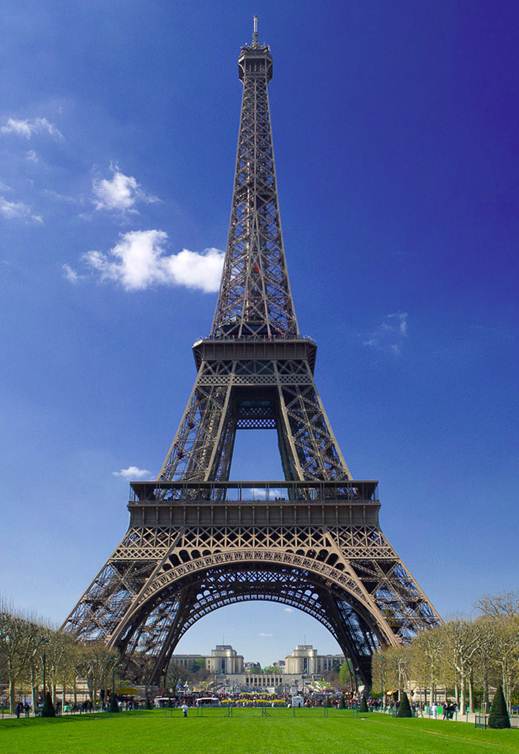4. Most mysterious: Stonehenge
There are certain obvious statements that
can be made about Stonehenge. It was certainly no natural occurrence or
coincidence; the main rock material is from nowhere near where the monoliths
now stand at Amesbury, Wiltshire, yet the geometric shapes and layout of the
remaining stones suggest they were laid in accordance with man-made designs.
And the stones themselves are enormous. Seriously big, with some weighing in at
an estimated 50 tonnes; to put this into perspective, this would take over 500
men to move just one with no machinery.

There were three known phases of
construction to the Henge, originally dating back around 5,000 years, but owing
to the stones’ durability, it has been difficult to pinpoint the dates in
between. Even more difficult was to know exactly what the purpose of it all
was. Dating back to the Neolithic and Bronze Ages, there are references to
human and animal bones found during excavations of the site, but none that
would suggest that its final purpose was that of a graveyard.
Today, aside from the tourists, the henge
is a destination for modern day Druids who flock to the relic each summer to
revere the ancient and mysterious monument at the Solstice. Others are visitors
who believe in the circle’s heating, fertility and Epiphanyesque qualities. But
the truth is that we don’t really know much about how, why or when this
undoubtedly significant work came to be; and this of course leaves the door
wide open to tales of olde folklore and colourful recounts…
With no written documentation from those
‘that were there’ we have stories including Merlin’s magic summoning the stones
from Ireland and placing them as gravestones to honour those that died
defending against the invading Saxon army; then there’s the tale of the dancing
wizards who were petrified under the spell of another rival wizard where they
stand to this day, frozen in time. Or was it really the African giants that
settled in Ireland, bringing with them a temple of stone which was re-erected
in Country Kildare before being magically transported to the Salisbury plain?
The only truth we can accept it that we are
unlikely ever to know how or why Stonehenge came to be, and must simply enjoy
its enigmatic charm.
5. Most spiritual: Ayers rock/ Uluru
There’s a reason souvenir-swiping tourists
in their thousands return the chunks of sandstone rock they’ve chipped away
from Ayers Rock in the spiritual heart of Australia; enclosed notes bemoan the
bad luck that’s occurred ever since they were stolen, and many simply say
‘sorry’.

But while the theft is prohibited, no-one
is aware of any kind of curse on those who carry off these tourist trophies;
and the Aboriginal people, while grateful for the piecemeal return of the rock,
remain bemused by the accompanying tales of woe. What the Aborigines do believe
however, is that Ayers Rock, which they only is it the natural and spiritual
centre of Australia, it is one of the most sacred places on earth.
Uluru rises a majestic 350 m out of the
arid, dusty Outback of Australia’s Northern Territory and forms the backbone of
the rich belief system of the Aboriginal people. Its creation, they believe,
dates back to the Dreamtime, when the ancestral beings rose up through the
ground of a flat, featureless earth and created the world around them. They
brought the sun, moon and stars, they carved the earth, they brought nature,
and they brought knowledge. And it is their spirits which now live in the
landscape, and in the giant sandstone rock.
Consequently the rock is revered, its
sublimity unsurpassed by any man-made shrine the world over.
When not photographing the almost hourly
colour changes for which Uluru is famed (a pinkish-red colour in the dawn
light, through to magenta and purple as night falls), tourists are able to
approach the Rock and walk around its 9 km circumference, punctuated with rock
paintings, crevices and sacred pools. The greatest sadness caused to the
Aboriginal people however, is the permission granted to tourists to climb
Uluru. To make a climbing frame of this ancient and spiritual wonder brings not
only great distress, but also sores of deaths as the climb is steep, slippery
and undertaken in extreme temperatures. All injuries and deaths are mourned at
length by the Aborigines, and they continually implore the authorities to
prohibit the climb, and to remove the metal posts, serving as guiderails, which
have been driven deep into their spiritual heart.
6.
Largest great: Wall of China
Man is
responsible for many a mark on earth’s surface, but only some are arguably as
impressive as the very best of Mother Nature’s creations. Just one such feat of
stringent engineering and raw determination, however, is the Great Wall of
China.

Sadly, the
lovingly retold myth that the Great Wall is visible from the moon is just that,
a myth; but this doesn’t stop the sheer scale of the structure from
overwhelming even the most resolute of muralists. The main section of the Wall
stretches an enormous 5,500 miles (including natural, impassable formations
that form part of the overall planned defence barrier) from the Shanhai Pass in
the east to Top Nur in the west. In fact, if one were to measure the sprawling
‘tributaries’ of the walls across the various contributing dynasties, we’d be
talking more like 13,000 miles…
With some
sections built as early as the seventh century BC, the wall has essentially
been in a constant state of rebuild and repair over the course of its
existence.
Initially
comprising various sections that were ultimately joined together to form one
solid structure, the Wall was designed to protect China’s northern region from
any unwanted factions drifting into Chinese territory.
The idea to
join up all of the older walls was executed during the Ming Dynasty in the
fourteenth century, in an effort to abate what had become a rather drawn-out
war of attrition against both Manchurian and Mongolian tribes; the Wall
eventually succumbed to the ongoing Manchu invasions as late as the seventeenth
century.

Unfortunately,
it is predicted that we may lose large sections of the Wall through natural
erosion leaving only the parts that support tourism in any real state of
repair. It’s no wonder that this awe-inspiring achievement of man attracts folk
from around the globe and it is very much on any travelers’ list of places to
see before they die. Unfortunately this, alongside the more acceptable natural
weathering from nature, is responsible for expediting the slow decay of the
Wall itself. Litter, graffiti and vandalism is rife among the fabled
watchtowers of the Great Wall and unfortunately, owing largely to the sheer
size and location, there’s little in the way of slowing the destructive
process.
7.
Most visited: The Eiffel Tower
A survey
conducted at the end of last year has revealed that more Brits have visited the
Eiffel Tower than they have Buckingham Place. While the purpose of the research
is to suggest that Brits are neglecting their heritage in favour of foreign
landmarks, it needs to be pointed out that the Eiffel Tower is, in fact, the
most visited of all the world’s landmarks. You’re unlikely to speak to many
people who haven’t stood somewhere under its speckled shade, or taken the trip
up to one of its three tiers.

Not so
popular in the early days, the Eiffel Tower met with massive opposition after
its construction for the 1889 World Fair from the artistic and literary elite
of Paris, who considered it abstract and ugly and in very bad taste. So much
so, that it was only spared from demolition in 1909 when its practical
potential as a platform for the transmitting antennas necessary for the new
science of radiotelegraphy was spotted.
Now the
image of Paris, and even France itself, the Eiffel Tower is the most visited
paid landmark in the world. With a total 200 million visitors since it was
shunned as the city’s bête noire, Gustave Eiffel’s iconic creation now commands
visitor figures pushing the seven million mark every year.
Of these
millions, many will simply stare up through the girders. For the fit (and/or
slightly less patient), the stairs can be taken to the first or second
platforms, and for those who can put up with the wait of hour for the lifts (we
did mention it was the most visited of all world landmarks), all three
platforms can be accessed at ease – unless of course, the Parisian wind has picked
up, in which case the third platform will be closed.
Unsurprisingly,
it’s also (un)officially the world’s most photographed landmark. Photo-sharing
website Flickr was analysed recently by experts who scanned almost 35bmillion
images, posted by 300,000 users, and revealed that the Eiffel Tower was top of
the snaps.